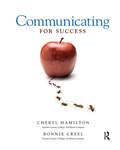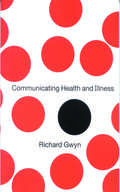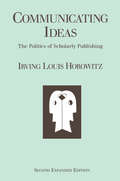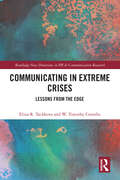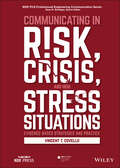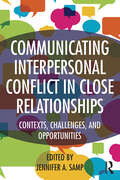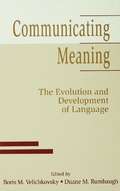- Table View
- List View
Communicating for Success
by Cheryl M. HamiltonThis text focuses student-learning on the key communication competencies recommended by the National Communication Association. With applied examples and a vibrant and engaging design, this text covers all the expected topics in an introductory course (foundations of communication, interpersonal communication, small group communication, and public speaking - plus a special appendix on interviewing). Scenarios begin each chapter with a problem to which students can relate and then solve as they learn about the concepts discussed in each chapter. A concentrated focus on careers in communication, highlighted in a two-page spread near the end of each chapter, brings home the relevance of communication outside the classroom and helps students learn more about how studying communication can help them throughout their lives. Additional emphasis on topics such as ethics, culture, gender, and technology is found throughout the text.
Communicating Gender
by Suzanne RomaineTaking a cross-disciplinary approach, Suzanne Romaine's main concern is to show how language and discourse play key roles in understanding and communicating gender and culture. In addition to linguistics--which provides the starting point and central focus of the book--she draws on the fields of anthropology, biology, communication, education, economics, history, literary criticism, philosophy, psychology, and sociology. The text covers the "core" areas in the study of language and gender, including how and where gender is indexed in language, how men and women speak, how children acquire gender differentiated language, and sexism in language and language reform. Although most of the examples are drawn primarily from English, other European languages and non-European languages, such as Japanese are considered. The text is written in an accessible way so that no prior knowledge of linguistics is necessary to understand the chapters containing linguistic analysis. Each chapter is followed by exercises and discussion questions to facilitate the book's use as a classroom text. The author reviews scholarly treatments of gender, and then uses her own data material from the corpora of spoken and written English usage. Special features include an examination of contemporary media sources such as newspapers, advertising, and television; a discussion of women's speculative fiction; a study of gender and advertising, with special attention paid to the role played by language in these domains; and a review of French feminist thought, particularly as it relates to the issue of language reform.
Communicating Gender
by Suzanne RomaineTaking a cross-disciplinary approach, Suzanne Romaine's main concern is to show how language and discourse play key roles in understanding and communicating gender and culture. In addition to linguistics--which provides the starting point and central focus of the book--she draws on the fields of anthropology, biology, communication, education, economics, history, literary criticism, philosophy, psychology, and sociology. The text covers the "core" areas in the study of language and gender, including how and where gender is indexed in language, how men and women speak, how children acquire gender differentiated language, and sexism in language and language reform. Although most of the examples are drawn primarily from English, other European languages and non-European languages, such as Japanese are considered. The text is written in an accessible way so that no prior knowledge of linguistics is necessary to understand the chapters containing linguistic analysis. Each chapter is followed by exercises and discussion questions to facilitate the book's use as a classroom text. The author reviews scholarly treatments of gender, and then uses her own data material from the corpora of spoken and written English usage. Special features include an examination of contemporary media sources such as newspapers, advertising, and television; a discussion of women's speculative fiction; a study of gender and advertising, with special attention paid to the role played by language in these domains; and a review of French feminist thought, particularly as it relates to the issue of language reform.
Communicating Health and Illness
by Dr Richard Gwyn`There has been a pressing need for a book like this for some time. Gwyn cogently reviews the literature on discourse analysis as it pertains to medical and health matters. Introducing original research from his own studies allows him to vividly illustrate just how important it is to understand the role played by discourse. Students of health communication and the sociology of health and illness will find this book integral to their studies' - Deborah Lupton In this book, Richard Gwyn demonstrates the centrality of discourse analysis to an understanding of health and communication. Focusing on language and communication issues he demonstrates that it is possible to observe and analyze patterns in the ways in which health and illness are represented and articulated by both health professionals and lay people. Communicating Health and Illness: Explores culturally validated notions of health and sickness and the medicalization of illness. Surveys media representations of health and illness Considers the metaphoric nature of talk about illness Contributes to the ongoing debate in relation to narrative based medicine.
Communicating Hope: An Ethnography of a Children's Mental Health Care Team
by Christine DavisKevin is a sometimes-violent teenager with severe emotional disturbance in a family environment of poverty and stress. In this ethnography of a children's mental health care team, communication scholar Christine S. Davis delves deeply into how members of the team create hope for themselves, for Kevin, and for his family using a strengths orientation and future focus. A rich, evocative narrative that highlights multiple voices and interpretations, Davis provides a multilayered study of how social service workers can motivate and heal troubled families in challenging environments. The volume includes clinical and practice considerations for those working in the social welfare system
Communicating Hope: An Ethnography of a Children's Mental Health Care Team
by Christine DavisKevin is a sometimes-violent teenager with severe emotional disturbance in a family environment of poverty and stress. In this ethnography of a children's mental health care team, communication scholar Christine S. Davis delves deeply into how members of the team create hope for themselves, for Kevin, and for his family using a strengths orientation and future focus. A rich, evocative narrative that highlights multiple voices and interpretations, Davis provides a multilayered study of how social service workers can motivate and heal troubled families in challenging environments. The volume includes clinical and practice considerations for those working in the social welfare system
Communicating Ice through Popular Art and Aesthetics (Palgrave Studies in Media and Environmental Communication)
by Anne Hemkendreis Anna-Sophie JürgensThis book brings together the perspectives of eminent and emerging scholars from fields as varied as science communication, art history, pop cultural studies, environmental studies, sciences studying ice and artists to explore the power of (popular) arts and aesthetics to communicate ice research and the urgency of environmental action. Examining the aesthetic strategies employed in images, (popular) visual fiction and narratives to convey meaning and awareness – and how they can be made fruitful for science communication – the project will generate new perspectives on how our collective environmental responsibility can be addressed and communicated across disciplines and divers audiences. In doing so, the volume will illuminate the cultural power of ice research and contribute to a better understanding of the cultural work that emerges from our ecological crisis.
Communicating Ideas: The Politics of Scholarly Publishing
by Irving Louis HorowitzCommunicating Ideas is the first attempt to place publishing in America in its political and commercial setting. The book addresses the political implications of scholarly communication in the era of the new computerized technology. Horowitz does so by examining classic problems of political theory in the context of property rights versus the presumed right to know, and the special strains involved in publishing as a business versus information as a public trust Offering a knowledgeable and insightful view of publishing in America and abroad, this book makes an important contribution to the study of mass culture in advanced societies.The discussion ranges considerably beyond scholarly publications into communication as a whole, encompassing a wide range of issues from cable and satelite television control to specialized issues in copyright legislation, the prize system in publishing, and the definition of standards of the industry. This new edition, expanded by fully one third, expands on such themes, and in addition deals with Horowitz's new research on the history of social science publishing.The first edition, published in 1986, was described by WE. Coleman as "a marvelous book which indeed offers a realistic analysis of publishing." John P. Dessauer declared that "no one thinking seriously about the future of scholarly communication can afford to ignore his work, in particular his treatment of basic issues." Joseph Gusfield (Los Angeles Times), in his review, noted that "Horowitz is alive to the possibilities and barriers for academics to reach a wider audience and for lay persons to utilize scholarship. Both groups can learn much from this intelligent book." And Philip G. Altbach (Scholarly Publishing) concluded his review by saying that Communicating Ideas "will be of interest not only to publishers and editors, but also to librarians and to sociologists of science."
Communicating Ideas: The Politics of Scholarly Publishing
by Irving Louis HorowitzCommunicating Ideas is the first attempt to place publishing in America in its political and commercial setting. The book addresses the political implications of scholarly communication in the era of the new computerized technology. Horowitz does so by examining classic problems of political theory in the context of property rights versus the presumed right to know, and the special strains involved in publishing as a business versus information as a public trust Offering a knowledgeable and insightful view of publishing in America and abroad, this book makes an important contribution to the study of mass culture in advanced societies.The discussion ranges considerably beyond scholarly publications into communication as a whole, encompassing a wide range of issues from cable and satelite television control to specialized issues in copyright legislation, the prize system in publishing, and the definition of standards of the industry. This new edition, expanded by fully one third, expands on such themes, and in addition deals with Horowitz's new research on the history of social science publishing.The first edition, published in 1986, was described by WE. Coleman as "a marvelous book which indeed offers a realistic analysis of publishing." John P. Dessauer declared that "no one thinking seriously about the future of scholarly communication can afford to ignore his work, in particular his treatment of basic issues." Joseph Gusfield (Los Angeles Times), in his review, noted that "Horowitz is alive to the possibilities and barriers for academics to reach a wider audience and for lay persons to utilize scholarship. Both groups can learn much from this intelligent book." And Philip G. Altbach (Scholarly Publishing) concluded his review by saying that Communicating Ideas "will be of interest not only to publishers and editors, but also to librarians and to sociologists of science."
Communicating Identities (Research and Resources in Language Teaching)
by Gary Barkhuizen Pat StraussCommunicating Identities is a book for language teachers who wish to focus on the topic of identity in the context of their classroom teaching. The work provides an accessible introduction to research and theory on language learner and language teacher identity. It provides a set of interactive, practical activities for use in language classrooms in which students explore and communicate about aspects of their identities. The communicative activities concern the various facets of the students’ own identities and are practical resources that teachers can draw on to structure and guide their students’ exploration of their identities. All the activities include a follow-on teacher reflection in which teachers explore aspects of their own identity in relation to the learner identities explored in the activities. The book also introduces teachers to practical steps in doing exploratory action research so that they can investigate identity systematically in their own classrooms.
Communicating Identities (Research and Resources in Language Teaching)
by Gary Barkhuizen Pat StraussCommunicating Identities is a book for language teachers who wish to focus on the topic of identity in the context of their classroom teaching. The work provides an accessible introduction to research and theory on language learner and language teacher identity. It provides a set of interactive, practical activities for use in language classrooms in which students explore and communicate about aspects of their identities. The communicative activities concern the various facets of the students’ own identities and are practical resources that teachers can draw on to structure and guide their students’ exploration of their identities. All the activities include a follow-on teacher reflection in which teachers explore aspects of their own identity in relation to the learner identities explored in the activities. The book also introduces teachers to practical steps in doing exploratory action research so that they can investigate identity systematically in their own classrooms.
Communicating in Digital Age Corporations
by Anna Danielewicz-BetzThe distinctive point of the book is its innovative interdisciplinary approach to business communication, with interconnections between linguistics, sociology, and critical organisational studies as applied to the corporate world. It offers a first-hand insight into primary business discourse with a deeper understanding and analysis of business processes and mechanisms underlying and reflected in enterprise software-mediated communication. It answers the question what ‘doing business’ in the digital age is about and illustrates ‘business discourse’ from practitioners’ point of view.Grounded in the analysis of empirical data, pertaining both to internal and external business communication, the author reflects on the reality of accelerated and pressurised communication in global IT corporations. Following a communication-centred approach, this monograph puts the topic of enterprise software-mediated business discourse into a multi-layered perspective of how global corporations operate, what their primary goals are, and what kind of (political) power they execute. Moreover, it demonstrates how profit-driven corporations can be viewed and interpreted as strategically acting systems within a specific sociological framework.
Communicating in English: Talk, Text, Technology
by Daniel Allington Barbara MayorCommunicating in English: Talk, Text, Technology looks at how people use spoken and written English to communicate in their everyday lives. Exploring the complex relationship between communication, technology and the English language, this book offers the reader practical insights into the analysis of speech and writing. A wide range of examples is provided, ranging from text messages and domestic quarrels to the works of Shakespeare and the words of Martin Luther King. This book takes a fresh look at established topics such as rhetoric, language acquisition, and professional communication, as well as covering exciting new fields such as everyday creativity, digital media, and the history of the book. Key theoretical concepts are introduced in an accessible manner, and the reader is given an in-depth understanding of English-language communication in its social and historical contexts. Drawing on the latest research and on the Open University’s experience of producing accessible and innovative texts, this book: • explains basic concepts and assumes no previous study of English studies, communication studies or linguistics • features a range of source material and commissioned readings to supplement chapters • includes contributions from leading experts in their fields, including Naomi Baron, Deborah Cameron, Guy Cook, Janet Holmes and Almut Koester • has a truly international scope, encompassing examples and case studies from Europe, North America, Africa, Asia, and Australasia • is illustrated in full colour and includes a comprehensive index. Communicating in English: Talk, Text, Technology is essential reading for all students of English language studies or communication studies.
Communicating in English: Talk, Text, Technology
Communicating in English: Talk, Text, Technology looks at how people use spoken and written English to communicate in their everyday lives. Exploring the complex relationship between communication, technology and the English language, this book offers the reader practical insights into the analysis of speech and writing. A wide range of examples is provided, ranging from text messages and domestic quarrels to the works of Shakespeare and the words of Martin Luther King. This book takes a fresh look at established topics such as rhetoric, language acquisition, and professional communication, as well as covering exciting new fields such as everyday creativity, digital media, and the history of the book. Key theoretical concepts are introduced in an accessible manner, and the reader is given an in-depth understanding of English-language communication in its social and historical contexts. Drawing on the latest research and on the Open University’s experience of producing accessible and innovative texts, this book: • explains basic concepts and assumes no previous study of English studies, communication studies or linguistics • features a range of source material and commissioned readings to supplement chapters • includes contributions from leading experts in their fields, including Naomi Baron, Deborah Cameron, Guy Cook, Janet Holmes and Almut Koester • has a truly international scope, encompassing examples and case studies from Europe, North America, Africa, Asia, and Australasia • is illustrated in full colour and includes a comprehensive index. Communicating in English: Talk, Text, Technology is essential reading for all students of English language studies or communication studies.
Communicating in Extreme Crises: Lessons from the Edge (Routledge New Directions in PR & Communication Research)
by Elina Tachkova W. Timothy CoombsThis book is an evidence-based approach to handling common, extreme crises. Extreme crises involve strong moral outrage; moral outrage creates situations where traditional crisis communication advice no longer is effective. These extreme crises create unique demands for crisis managers. Moreover, much of the traditional advice and crisis key performance indicators (KPIs) no longer apply. Validated through research, the book establishes the nature of extreme crises, the optimal crisis response for such crises, and the KPIs (outcomes) crisis managers need to measure for extreme crises. It serves as a guide for how to communicate effectively during extreme crises and provides advice based upon experimental research that validates the effectiveness of the crisis communication interventions. Readers do not require prior knowledge about crisis communication and crisis management as the book contains summaries of crisis communication and management before exploring the more specialized topic of extreme crises. Chapters include extended case studies, examining communication within such events as the Westpac money laundering, VW emissions and COVID-19 crises. Communications in Extreme Crises will be of direct interest to scholars of crisis communication in public relations, corporate communication, strategic communication, organizational communication programs and management.
Communicating in Extreme Crises: Lessons from the Edge (Routledge New Directions in PR & Communication Research)
by Elina Tachkova W. Timothy CoombsThis book is an evidence-based approach to handling common, extreme crises. Extreme crises involve strong moral outrage; moral outrage creates situations where traditional crisis communication advice no longer is effective. These extreme crises create unique demands for crisis managers. Moreover, much of the traditional advice and crisis key performance indicators (KPIs) no longer apply. Validated through research, the book establishes the nature of extreme crises, the optimal crisis response for such crises, and the KPIs (outcomes) crisis managers need to measure for extreme crises. It serves as a guide for how to communicate effectively during extreme crises and provides advice based upon experimental research that validates the effectiveness of the crisis communication interventions. Readers do not require prior knowledge about crisis communication and crisis management as the book contains summaries of crisis communication and management before exploring the more specialized topic of extreme crises. Chapters include extended case studies, examining communication within such events as the Westpac money laundering, VW emissions and COVID-19 crises. Communications in Extreme Crises will be of direct interest to scholars of crisis communication in public relations, corporate communication, strategic communication, organizational communication programs and management.
Communicating in Hospital Emergency Departments: Report For The Canberra Hospital
by Diana Slade Marie Manidis Jeannette McGregor Hermine Scheeres Eloise Chandler Jane Stein-Parbury Roger Dunston Maria Herke Christian M.I.M. MatthiessenThis book was conceived in response to the increasing recognition of the central role of communication in effective healthcare delivery, particularly in high-stress contexts. Over a three-year period, the research team investigated communication between patients and clinicians in five representative emergency departments (EDs). The book describes the communicative complexity and intensity of work in the ED and identifies the features of successful patient-clinician interactions. Drawing on authentic examples of communication within the ED, the book provides comprehensive communication strategies for healthcare professionals that can be readily integrated into everyday practice. ‘Professor Diana Slade and her colleagues have written an innovative and practical book on communication and relationships in emergency departments and their effects on the patient experience. Rarely does one find a book that so seamlessly translates research findings into practical action strategies. The book is an invaluable resource for the training of physicians, nurses, hospital administrators and others in healthcare.’ - Elizabeth A. Rider, MSW, MD, FAAP, Department of Pediatrics, Harvard Medical School ‘My participation in the UTS Emergency Communication project provided extraordinary insights into the complexities and subtleties of communication encounters during a patient’s emergency department journey. This project has made a lasting impact on my daily work, and I hope will improve emergency patient care into the future.’ - Dr Nick Taylor, Emergency Medicine Specialist, The Canberra Hospital ‘The captured clinical conversations between doctors, nurses and patients are fascinating... The discussion and conclusions provide a rare insight into an integral and critical component of Emergency Medicine practice. The team, led by Professor Slade, was truly unobtrusive, professional and personable.’ - Dr Marian Lee, Emergency Physician, Director of Emergency Medicine Training
Communicating in Risk, Crisis, and High Stress Situations: Evidence-Based Strategies and Practice (IEEE PCS Professional Engineering Communication Series)
by Vincent T. CovelloLEARN THE UNIFYING PRINCIPLES BEHIND RISK, CRISIS, AND HIGH STRESS COMMUNICATION WITH THIS STATE-OF-THE-ART REFERENCE WRITTEN BY A MAJOR LEADER IN THE FIELD Communicating in Risk, Crisis, and High Stress Situations: Evidence-Based Strategies and Practice is about communicating with people in the most challenging circumstances: high stress situations characterized by high risks and high stakes. The ability to communicate effectively in a high stress situation is an essential communication competency for managers, engineers, scientists, and professionals in every field who can be thrust into demanding situations complicated by stress. Whether you are confronting an external crisis, an internal emergency, or leading organizational change, this book was written for you. Communicating in Risk, Crisis, and High Stress Situations brings together in one resource proven scientific research with practical, hands-on guidance from a world leader in the field. The book covers such critical topics as trust, stakeholder engagement, misinformation, messaging, and audience perceptions in the context of stress. This book is uniquely readable, thorough, and useful, thanks to features that include: Evidence-based theories and concepts that underlie and guide practice Tools and guidelines for practical and effective planning and application Experience-based advice for facing challenges posed by mainstream and social media Provocative case studies that bring home the key principles and strategies Illuminating case diaries that use the author’s breadth and depth of experience to create extraordinary learning opportunitiesThe book is a necessity for managers, engineers, scientists, and others who must communicate difficult technical concepts to a concerned public. It also belongs on the bookshelves of leaders and communicators in public and private sector organizations looking for a one-stop reference and evidence-based practical guide for communicating effectively in emotionally charged situations. Written by a highly successful academic, consultant, and trainer, the book is also designed as a resource for training and education.
Communicating in Risk, Crisis, and High Stress Situations: Evidence-Based Strategies and Practice (IEEE PCS Professional Engineering Communication Series)
by Vincent T. CovelloCOMMUNICATING IN R!SK, CRISIS, AND HIGH STRESS SITUATIONS LEARN THE UNIFYING PRINCIPLES BEHIND RISK, CRISIS, AND HIGH STRESS COMMUNICATION WITH THIS STATE-OF-THE-ART REFERENCE WRITTEN BY A MAJOR LEADER IN THE FIELD Communicating in Risk, Crisis, and High Stress Situations: Evidence-Based Strategies and Practice is about communicating with people in the most challenging circumstances: high stress situations characterized by high risks and high stakes. The ability to communicate effectively in a high stress situation is an essential communication competency for managers, engineers, scientists, and professionals in every field who can be thrust into demanding situations complicated by stress. Whether you are confronting an external crisis, an internal emergency, or leading organizational change, this book was written for you. Communicating in Risk, Crisis, and High Stress Situations brings together in one resource proven scientific research with practical, hands-on guidance from a world leader in the field. The book covers such critical topics as trust, stakeholder engagement, misinformation, messaging, and audience perceptions in the context of stress. This book is uniquely readable, thorough, and useful, thanks to features that include: Evidence-based theories and concepts that underlie and guide practice Tools and guidelines for practical and effective planning and application Experience-based advice for facing challenges posed by mainstream and social media Provocative case studies that bring home the key principles and strategies Illuminating case diaries that use the author’s breadth and depth of experience to create extraordinary learning opportunities The book is a necessity for managers, engineers, scientists, and others who must communicate difficult technical concepts to a concerned public. It also belongs on the bookshelves of leaders and communicators in public and private sector organizations looking for a one-stop reference and evidence-based practical guide for communicating effectively in emotionally charged situations. Written by a highly successful academic, consultant, and trainer, the book is also designed as a resource for training and education.
Communicating Interpersonal Conflict in Close Relationships: Contexts, Challenges, and Opportunities
by Jennifer A. SampCommunicating Interpersonal Conflict in Close Relationships: Contexts, Challenges, and Opportunities provides a state-of-the-art review of research on conflict in close personal relationships. This volume brings together both seasoned and new voices in communication research to address the challenges in evaluating conflict. Contributors review the current state of research on themes related to power, serial arguments, interpersonal and family dynamics, physiological processes, and mechanisms of forgiveness by presenting theoretical reviews, original unpublished data-driven research, and discussions about the methodological challenges and opportunities in studying interpersonal conflict. An essential resource for graduate students and faculty interested in interpersonal conflict in close relationships between romantic partners, families, or friends, this volume is intended for advanced coursework and individual study in communication, social psychology, and close relationship scholarship.
Communicating Interpersonal Conflict in Close Relationships: Contexts, Challenges, and Opportunities
by Jennifer A. SampCommunicating Interpersonal Conflict in Close Relationships: Contexts, Challenges, and Opportunities provides a state-of-the-art review of research on conflict in close personal relationships. This volume brings together both seasoned and new voices in communication research to address the challenges in evaluating conflict. Contributors review the current state of research on themes related to power, serial arguments, interpersonal and family dynamics, physiological processes, and mechanisms of forgiveness by presenting theoretical reviews, original unpublished data-driven research, and discussions about the methodological challenges and opportunities in studying interpersonal conflict. An essential resource for graduate students and faculty interested in interpersonal conflict in close relationships between romantic partners, families, or friends, this volume is intended for advanced coursework and individual study in communication, social psychology, and close relationship scholarship.
Communicating Linguistics: Language, Community and Public Engagement
by Hazel Price and Dan McIntyreIncreasingly, academics are called upon to demonstrate the value of linguistics and explain their research to the wider public. In support of this agenda, Communicating Linguistics: Language, Community and Public Engagement provides an overview of the wide range of public engagement activities currently being undertaken in linguistics, as well as practically focused advice aimed at helping linguists to do public engagement well. From podcasts to popular writing, from competitions to consultancy, from language creation to community projects, there are many ways in which linguists can share their research with the public. Bringing together insights from leading linguists working in academia as well as non-university professions, this unique collection: • Provides a forum for the discussion of challenges and opportunities of public engagement in linguistics in order to shape best practice. • Documents best practice through a summary of some of the many excellent public engagement projects currently taking place internationally. • Celebrates the long tradition of public engagement in linguistics, a discipline which is often misunderstood despite its direct and fundamental importance to everyday life. Breaking down long-standing divisions between universities and the wider community, this book will be of significant value to academics in linguistics but also teachers, policy makers and anyone interested in better understanding the nature and use of language in society.
Communicating Linguistics: Language, Community and Public Engagement
by Hazel Price Dan McIntyreIncreasingly, academics are called upon to demonstrate the value of linguistics and explain their research to the wider public. In support of this agenda, Communicating Linguistics: Language, Community and Public Engagement provides an overview of the wide range of public engagement activities currently being undertaken in linguistics, as well as practically focused advice aimed at helping linguists to do public engagement well. From podcasts to popular writing, from competitions to consultancy, from language creation to community projects, there are many ways in which linguists can share their research with the public. Bringing together insights from leading linguists working in academia as well as non-university professions, this unique collection: • Provides a forum for the discussion of challenges and opportunities of public engagement in linguistics in order to shape best practice. • Documents best practice through a summary of some of the many excellent public engagement projects currently taking place internationally. • Celebrates the long tradition of public engagement in linguistics, a discipline which is often misunderstood despite its direct and fundamental importance to everyday life. Breaking down long-standing divisions between universities and the wider community, this book will be of significant value to academics in linguistics but also teachers, policy makers and anyone interested in better understanding the nature and use of language in society.
Communicating Meaning: The Evolution and Development of Language
by Boris M. Velichkovsky Duane M. RumbaughDealing specifically with the origins and development of human language, this book is based on a selection of materials from a recent international conference held at the Center of Interdisciplinary Research at the University of Bielefeld in Germany. The significance of the volume is that it testifies to paradigmatic changes currently in progress. The changes are from the typical emphasis on the syntactic properties of language and cognition to an analysis of biological and cultural factors which make these formal properties possible. The chapters provide in-depth coverage of such topics as new theoretical foundations for cognitive research, phylogenetic prerequisites and ontogenesis of language, and environmental and cultural forces of development. Some of the arguments and lines of research are relatively well-known; others deal with completely new interdisciplinary approaches. As a result, some of the authors' conclusions are in part, rather counterintuitive, such as the hypothesis that language as a system of formal symbolic transformations may be in fact a very late phenomenon located in the sphere of socio-cultural and not biological development. While highly debatable, this and other hypotheses of the book may well define research questions for the future.
Communicating Meaning: The Evolution and Development of Language
by Boris M. Velichkovsky Duane M. RumbaughDealing specifically with the origins and development of human language, this book is based on a selection of materials from a recent international conference held at the Center of Interdisciplinary Research at the University of Bielefeld in Germany. The significance of the volume is that it testifies to paradigmatic changes currently in progress. The changes are from the typical emphasis on the syntactic properties of language and cognition to an analysis of biological and cultural factors which make these formal properties possible. The chapters provide in-depth coverage of such topics as new theoretical foundations for cognitive research, phylogenetic prerequisites and ontogenesis of language, and environmental and cultural forces of development. Some of the arguments and lines of research are relatively well-known; others deal with completely new interdisciplinary approaches. As a result, some of the authors' conclusions are in part, rather counterintuitive, such as the hypothesis that language as a system of formal symbolic transformations may be in fact a very late phenomenon located in the sphere of socio-cultural and not biological development. While highly debatable, this and other hypotheses of the book may well define research questions for the future.
